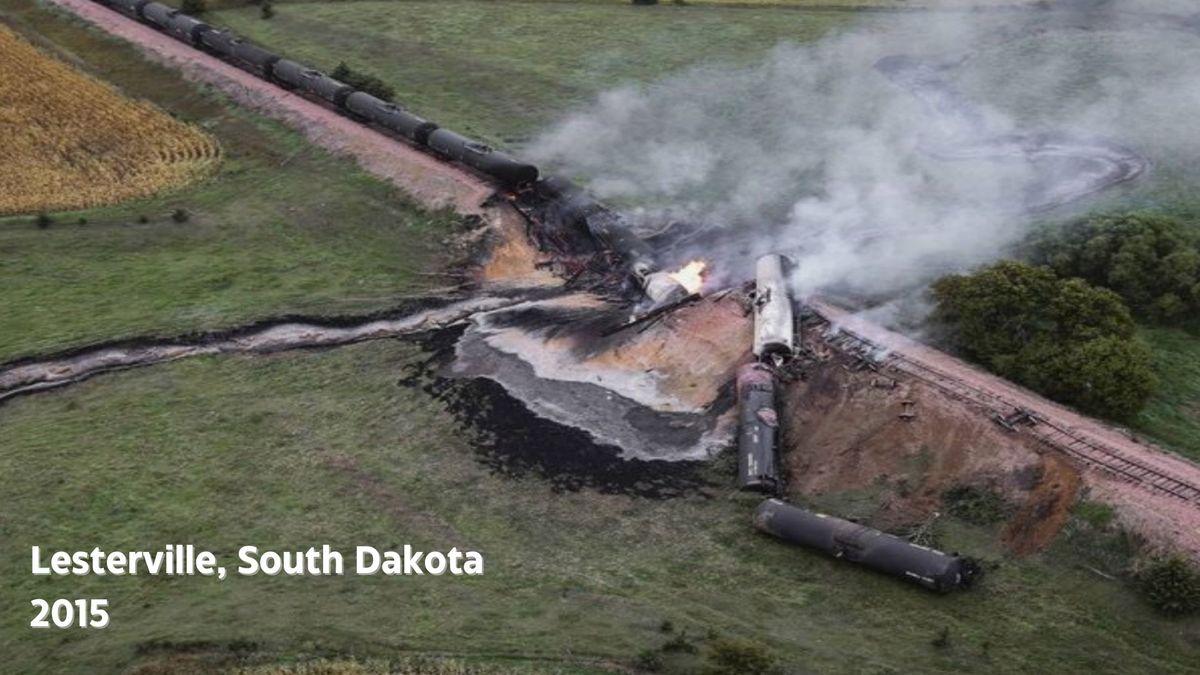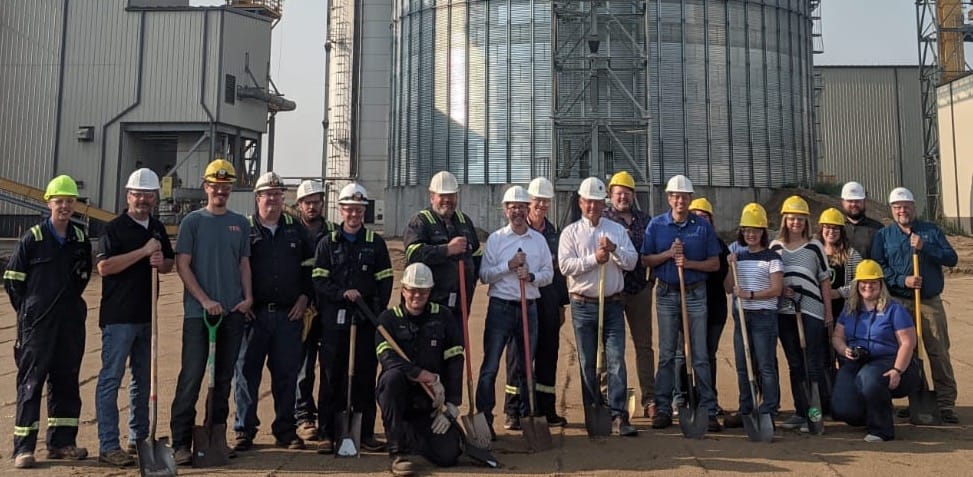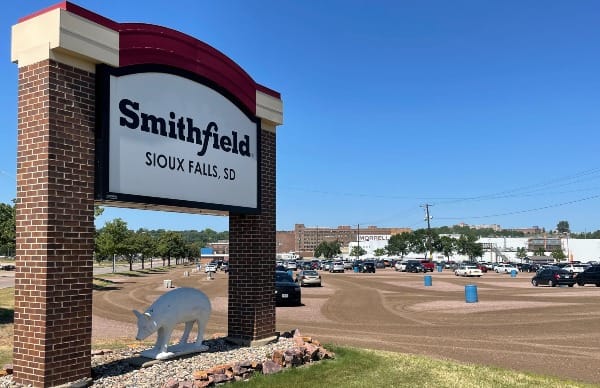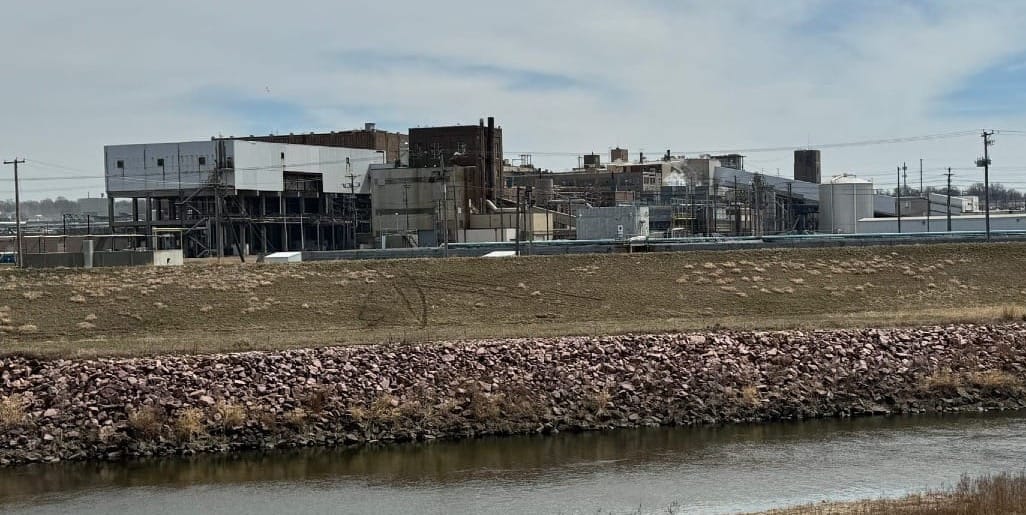Newly released federal data show that South Dakota businesses and industries released nearly 7.5 million pounds of toxic chemicals in the air, water and land in 2024 but also reveal that long-time leading polluter Smithfield Foods in Sioux Falls drastically cut its releases.
The numbers come from the Environmental Protection Agency's annual Toxic Release Inventory (TRI), a report listing generation and release amounts of more than a dozen different toxic chemicals by industry and government in all U.S. states and territories.
The 2024 data for South Dakota reveal a few key data points, including:
- The most commonly released chemicals include nitrates into water, hexane into the air and lead onto land surfaces. Nitrates are used in food production, hexane is a byproduct of feed and fuel production and lead results from mining operations.
- South Dakota is in the lowest 10% of states and territories in terms of chemical release levels and is the lowest among all neighboring states.
- Recycling of chemical wastes and byproducts is on the rise in South Dakota and across the country as companies work to reduce their chemical footprints.
- In a major shift, gold and silver mining company Wharf Resources of Lead overtook Smithfield Foods as the state’s biggest releaser of toxic chemicals. Smithfield, a pork processor located on the Big Sioux River, installed a $45 million wastewater treatment facility in 2023 and saw a 77% reduction in nitrates and ammonia released by the plant in 2024.
The purpose of the TRI is to inform the public about industrial chemical releases and to aid companies in tracking and ideally reducing wastes or being more aggressive in waste treatment and handling, EPA spokesman Jeffrey Landis wrote to News Watch in an email.
The TRI is not a comprehensive list of all chemical releases because it does not include agricultural runoff or bacterial releases, the EPA said. Most of the chemicals listed in the TRI have been treated prior to release. And most releases are done within permit limits set by state and federal regulators, the agency said.

Jay Gilbertson, manager of the East Dakota Water Development District, is a longtime advocate of pollution reduction. Lowering industrial emissions is an important goal, Gilbertson said, while acknowledging that producing goods or processing foods will create waste or byproducts.
"If you want to have those economic development opportunities and the products that result, hardly any process is free of emissions of some sort, so it’s not a big surprise these companies are major emitters of chemicals,” Gilbertson said. “It is pollution. But it is pollution taking place under the watchful eye of regulators.”
Millions of pounds but still on the low side
In all, 107 South Dakota industries and businesses and five governmental entities tracked by the TRI released nearly 7.5 million pounds of chemicals in the air, water or land surfaces including landfills. The 2024 release total represents a slight increase from 2023, when 7.2 million pounds were released.
About 30% of the chemicals are released into the water, 28% into the air, 27% onto land and 14% in off-site locations or other disposal methods. Of the 340 chemical releases noted in the 2024 TRI, 95 of those included carcinogenic materials.
The top South Dakota releasers in 2024, what they released and where, according to the TRI:
- Wharf Resources gold mine at Lead: lead and other chemicals onto land
- Smithfield Foods pork processing plant in Sioux Falls: nitrates and ammonia into the Big Sioux River
- Novita Aurora of Brookings County, an animal nutrition company: hexane into the air
- Workhorse Cabs/Crenlo Engineering of Watertown, which manufactures large machinery cabs: manganese/chromium to the air and off-site facilities
- South Dakota Soybean Processors of Volga: hexane into the air
South Dakota's generation of 24.3 million pounds of chemicals and release of 7.5 million pounds in 2024 were both the lowest levels among all neighboring states, likely due to the state's relatively small number of large industrial companies.
The highest releases were in Montana, where 52.3 million pounds of chemicals were released. North Dakota was second in the release level at 49.3 million pounds, followed by Iowa with 34 million pounds.
The highest individual chemical release in the nation in 2024 was at Red Dog Operations mine in Kotzebue, Alaska, where 380.8 million pounds of zinc were released. In the Great Plains, the single largest release of 17.5 million pounds of ammonia took place at Basin Electric Antelope Valley Station in Mercer, North Dakota.
Wharf mine seeks to limit releases
The 2024 data indicate that Wharf, a mining operation owned by Chicago-based Coeur Mining, released nearly 2.7 million pounds of eight separate chemicals in 2024.
The top chemical released was 2.4 million pounds of lead and lead compounds, which were released onto the land. Other chemicals released by Wharf include nitrates, chromium, manganese, methanol, sodium nitrate and cyanide compounds, according to the TRI.
Wharf’s chemical releases reached a peak in 2024 and rose by 37% compared to 2023 when less than 2 million pounds were released. EPA data show the company has increased its waste treatment efforts during the past two years but has not implemented new pollution prevention methods since 2006.
Join other South Dakotans and support statewide storytelling.
Jasmine McCauley, environmental manager for Coeur Resources, said the company takes numerous steps and uses the latest technology to minimize the release of chemicals during its mining processes.
She added that some chemical release amounts in the TRI could be misleading in terms of where waste products end up.
For instance, the lead and lead compounds listed in the TRI are shown as being deposited in landfills, when in reality the lead is in the earth prior to mining and is put back onto the land within the mine site after valuable minerals are extracted, McCauley said.
Other chemicals released by Wharf are treated prior to release, including nitrates present in effluent that is discharged into Annie Creek along the mine property. Wharf has 100 monitoring wells it checks monthly to ensure compliance with state and federal regulations, she said. The company also works to “scrub” mercury from materials released during the mining process.
“We do quite a bit to manage our footprint and we have permits from several regulatory agencies, so we make sure our footprint doesn’t impact anyone downstream,” McCauley said. “It’s important that we do this responsibly.”
Hexane released by feed and fuel producer
The third highest chemical releases in South Dakota in 2024 occurred at Novita Aurora, a feed and sustainable fuel production company located in Brookings County.
Don Endres, CEO of Novita LLC, said the company that employs about 70 people has found new uses for distillers grains, a byproduct of the ethanol process.

The company re-purposes distillers grains by using a solvent to remove corn oil embedded within the grains as part of a process to convert the grains to livestock meal, he said. The extracted oil is then used as an additive to renewable diesel fuel.
The solvent includes hexane, a volatile chemical compound that is toxic to humans. Some of the hexane is released into the air, and some of it remains in the oil used in the diesel fuel, he said.
The TRI indicates Novita released 459,000 pounds of hexane in 2024, a reduction from 755,000 pounds released in 2023.
Endres said the year-over-year reduction in hexane release — which came even as production levels increased — is indicative of the company’s ongoing efforts to reduce its chemical releases which come as a result of making cleaner fuels for cars and trucks.
“We’re very aware of (the TRI) and are continuing to make improvements over time,” he told News Watch. “To the extent society needs fuel, we want to continue to be more efficient and have less of a carbon footprint in total.”
Smithfield sees major decline in releases
In response to new state permit requirements in 2020 that included a limit on nitrate releases, Smithfield in May 2023 opened a $45 million water treatment facility at the plant next to Falls Park in Sioux Falls.
Prior to that, the company spent another $10 million on pollution reduction systems, said Jason Lindquist, director of environmental health and safety at Smithfield.
Smithfield, which slaughters nearly 20,000 hogs a day and processes a daily flow of 3 million gallons of wastewater, saw its total chemical releases drop from 5.27 million pounds in 2021 to 1.13 million pounds in 2024, according to the TRI. Last year, the company released 1.1 million pounds of nitrates and 51,400 pounds of ammonia, both major reductions from 2022.

The new treatment system takes the nitrates drawn from ammonia and uses a denitrifying system to biologically convert them to nitrogen gas, which is much less harmful.
"From a wastewater perspective, going through denitrification and the addition of the new plant made us more effective at reducing nitrates and ammonia," Lindquist said. "Smithfield is committed to 100% compliance 100% of the time, and that’s not just a tagline because we work our tails off to meet those permit requirements."
Environmental groups the Sierra Club and Dakota Rural Action did not respond to emails seeking comment.
Gilbertson, the water manager, praised the efforts of Smithfield to reduce nitrate releases into the Big Sioux River. But he noted that the reduction is small in comparison to nutrient loads coming from agricultural operations and industrial facilities along the river and in municipal wastewater effluent dumped by Sioux Falls and other cities.
“The idea that the Big Sioux River will become a crystal clear trout stream is an aspirational goal, but it’s probably unrealistic,” Gilbertson said. “And yet, we have waters in South Dakota, many lakes and rivers, where we have an excess of nutrients in them, so anything to reduce that load is a good thing.”
This story was produced by South Dakota News Watch, an independent, nonprofit organization. Read more stories and donate at sdnewswatch.org and sign up for an email to get stories when they're published. Contact Bart Pfankuch at bart.pfankuch@sdnewswatch.org.








